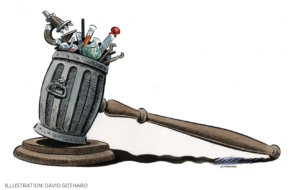
As an orthopedic surgeon, I’m often called to serve as an expert witness in personal injury and malpractice litigation. Over the last 40 years, I’ve given hundreds of depositions and appeared in court on numerous occasions. During that time, I’ve learned the importance of knowing what you’re saying and being sure you’ve got the facts, and the science, to back you up.
There’s something called a Daubert challenge that every expert witness must be aware of and ready to defend. The term comes from a case in 1993, Daubert v. Merrell Dow Pharmaceuticals, which was decided by The Supreme Court. The case concerned the drug Bendectin, commonly used to ease morning sickness during pregnancy. Epidemiological studies consistently found no association, let alone causation, between the drug and birth defects. Yet plaintiffs in one case consulted with a cadre of experts who sliced and diced existing data to conclude otherwise. Their findings were never published in a peer-reviewed journal.
Robert P. Charrow, writing in The Wall Street Journal, tells us the court, adhering to a federal statute, instructed federal trial judges to act as gatekeepers by permitting testimony about scientific opinions only if it amounted to “good science,” developed in accordance with the scientific method. Such opinions, the justices added, must also “fit” the issue before the court. If a case were about whether a drug caused a disease in humans, its effect on animals likely wouldn’t suffice. The high court instructed the lower court to consider the propriety of the plaintiff’s expert testimony in light of its opinion.
When the lower court reconsidered the evidence in light of Daubert, it held that reanalyzing existing data for litigation and failing to publish such analysis in a peer-reviewed journal fails to ensure its reliability and isn’t consistent with the scientific method. Most states have adopted this approach.
Requiring a judge to act as a gatekeeper ensures that testimony is scientifically sound. It likewise ensures that judges follow the same rules when evaluating scientific evidence. Daubert doesn’t require that every expert have the same opinion—it simply ensures that judges will maintain guardrails. As in baseball, abiding by the same rules ensures that if a player hits a ball into the bleachers behind home plate, every umpire would call it a foul. The rules make the game, much as the scientific method makes science.
This brings us to the current situation where two mass products liability cases – in Florida federal court and Delaware state court – have had two different outcomes. Both cases concern the drug ranitidine, the active ingredient in the heartburn medication Zantac and its generic counterparts. Thousands of plaintiffs claim the drug caused them to develop at least one of several types of cancer. Both courts consider Daubert controlling precedent. Both analyses therefore should have been nearly identical. In practice, however, they were diametrically opposed.
Mr. Charrow tells us in a December 2022 opinion, federal judge Robin Rosenberg of Florida examined the plaintiffs’ expert opinions, which claimed that Zantac and other ranitidine-based drugs caused cancer because their active ingredient can degrade into the carcinogen NDMA, which is also found in smoked meats.
Yet to prove that claim, one must demonstrate the drug exhibits consistent positive associations with certain cancers across a series of human studies. No such relationship existed. The human studies didn’t show a consistent statistically significant and valid association between ranitidine use and cancer, let alone causation. Based on these, along with another study from the Food and Drug Administration, the agency and its European counterpart concluded that ranitidine poses no risk of cancer. The judge followed these assessments and excluded the plaintiffs’ expert testimony.
The Delaware court on May 31 reached the opposite conclusion in In re Zantac (Ranitidine) Litigation. Judge Vivian L. Medinilla’s opinion discounted epidemiology studies and the FDA’s conclusions. She relied instead on studies of NDMA—the chemical, not the drug—which showed a positive association between certain workers’ exposure to NDMA and cancer.
The FDA’s fellow public-health agency, the Agency for Toxic Substances and Disease Registry, reviewed at least one of these same studies and decided it couldn’t draw the same dispositive conclusions from it. Its limitations, the agency noted,“make it difficult to establish clear associations between NDMA exposure and mortality from specific cancers.” The studied workers were exposed to scores of carcinogens, which made linking cancer to one chemical scientifically impossible.
Mr. Charrow responds, “Yet these expert decisions didn’t trouble Judge Medinilla. In her view, the jury could second-guess federal agencies, as well as those who conducted the independent epidemiology studies, so long as other experts disagreed. The court effectively put a foul ball into play.”
Clearly, the Delaware judge is not following the science. The Daubert decision was supposed to make this impossible. It is the judge’s responsibility to keep the expert witnesses in line and prevent unproven scientific theory from deciding cases.
I’ve never had a Daubert challenge to my testimony in 40 years. But if I ever start testifying based on my theories, and not the proven science, I should.

